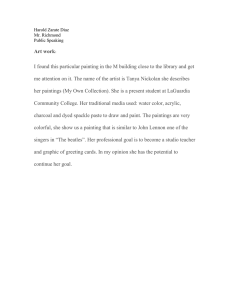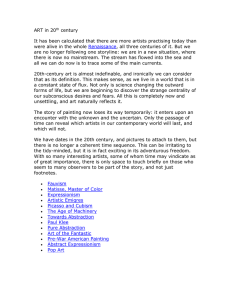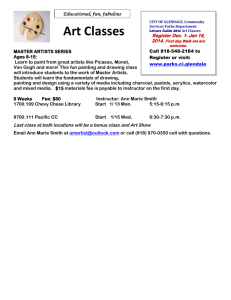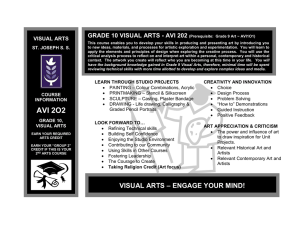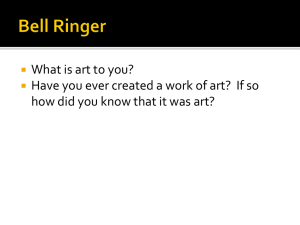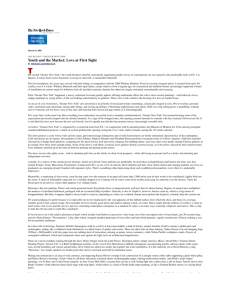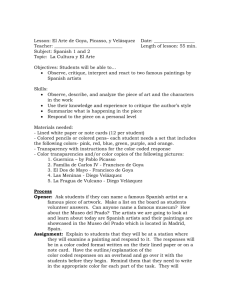Suggested Activities - Imperial War Museum
advertisement
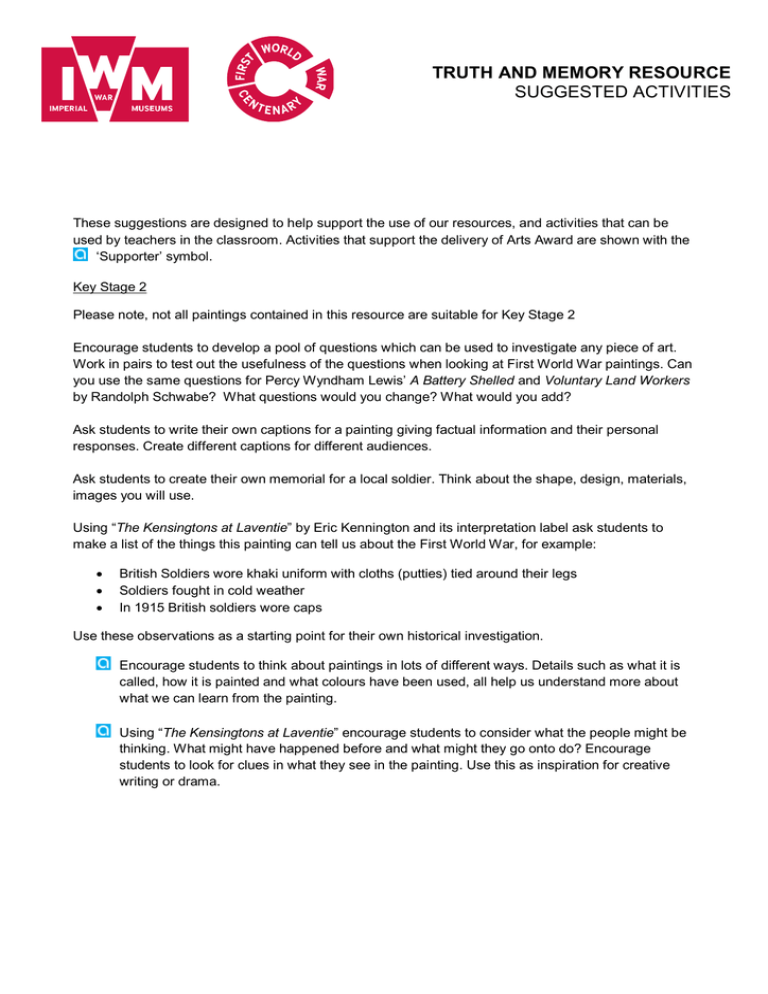
TRUTH AND MEMORY RESOURCE SUGGESTED ACTIVITIES These suggestions are designed to help support the use of our resources, and activities that can be used by teachers in the classroom. Activities that support the delivery of Arts Award are shown with the ‘Supporter’ symbol. Key Stage 2 Please note, not all paintings contained in this resource are suitable for Key Stage 2 Encourage students to develop a pool of questions which can be used to investigate any piece of art. Work in pairs to test out the usefulness of the questions when looking at First World War paintings. Can you use the same questions for Percy Wyndham Lewis’ A Battery Shelled and Voluntary Land Workers by Randolph Schwabe? What questions would you change? What would you add? Ask students to write their own captions for a painting giving factual information and their personal responses. Create different captions for different audiences. Ask students to create their own memorial for a local soldier. Think about the shape, design, materials, images you will use. Using “The Kensingtons at Laventie” by Eric Kennington and its interpretation label ask students to make a list of the things this painting can tell us about the First World War, for example: • • • British Soldiers wore khaki uniform with cloths (putties) tied around their legs Soldiers fought in cold weather In 1915 British soldiers wore caps Use these observations as a starting point for their own historical investigation. Encourage students to think about paintings in lots of different ways. Details such as what it is called, how it is painted and what colours have been used, all help us understand more about what we can learn from the painting. Using “The Kensingtons at Laventie” encourage students to consider what the people might be thinking. What might have happened before and what might they go onto do? Encourage students to look for clues in what they see in the painting. Use this as inspiration for creative writing or drama. Key Stage 3 Encourage students to think of reasons why an artwork was created. Who commissioned it and where was it to be placed? What does this help us understand about it? And does this change our response to it? Encourage students to think about the style, medium and colours, of the artwork. Consider how they impact on the effectiveness of the piece. Use contemporary photographs and films, such as the 1916 film the “Battle of the Somme,” to compare landscapes and experiences depicted in the paintings. Ask students to think about what we can learn about the First World War from the piece of art. This might relate to uniforms, organisation, types of warfare, locations and emotional responses or the use of art as government propaganda. Choose one theme to begin an investigation into this topic. Encourage students to research how contemporary artists are recording current conflicts. You could start with the Artists in our Contemporary Art and War Learning Resource: • http://www.iwm.org.uk/learning/resources/contemporary-art-and-war Following on from their own research into a selection of paintings ask students to create labels of knowledge and labels of interpretation. Present to the rest of the group. Discussion Point: Have you ever been in extreme circumstances? Which medium would best help you to describe or portray that experience? Would sound or movement better convey that experience than art? 2 Key Stage 4 and post-16 Encourage students to explore how contemporary artists are commemorating those who have died in conflicts. Consider the different approaches of: • • Rozanne Hawksley: http://www.iwm.org.uk/collections/item/object/42009 Steve McQueen: http://www.iwm.org.uk/collections/item/object/18675 Encourage students to investigate and record every day memorials such as ghost bikes, roadside tributes and shrines. What forms do these memorials take? What aspects of the person do they commemorate? How are they embedded in their environment? How do they change overtime? What reactions do they evoke from passers-by? Using Eric Kennington’s “The Kensingtons at Laventie” and Jagger’s “The Worcesters at Gheluvult” encourage students to analyse these startlingly different works of art. Explore content, medium, use of colour, message and composition. A practical starting point might be to draw quick thumbnail sketches of the directional lines in each piece. In the painting of the “The Kensingtons at Laventie” one of the figures has a Pickelhaube, a German Helmet, attached to his belt. The helmet, which was already a symbol of German imperialism and had been widely used in British anti-German propaganda, was collected as a war souvenir by opposition soldiers. Encourage students to research war trophies and souvenirs. Also explore collected objects from other events. Consider why and what people collect. Discussion Points: Awe inspiring nature and proximity to direct danger provided inspiration for eighteenth century artists such as Caspar David Friedrich. Consider how the artistic experience for the Western Front links to the Sublime. Many of the artists in the First World War also served as soldiers. How might this have shaped and informed their work? How does this differ from contemporary war artists most of whom are observers rather than combatants? 3
